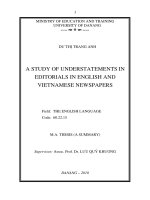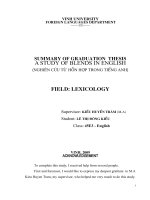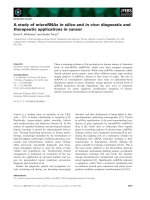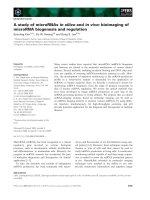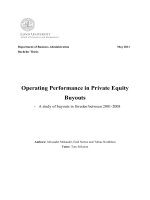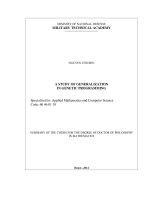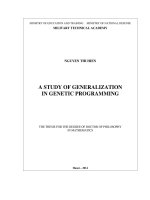A study of major sources of borrowings in english vocabulary = nghiên cứu những nguồn vay mượn chính trong từ vựng tiếng anh
Bạn đang xem bản rút gọn của tài liệu. Xem và tải ngay bản đầy đủ của tài liệu tại đây (563.77 KB, 80 trang )
HANOI PEDAGOGICAL UNIVERSITY
2
FOREIGN LANGUAGE
FACULTY
HOÀNG THỊ MINH HẢO
A STUDY OF MAJOR SOURCES OF BORROWINGS
IN ENGLISH VOCABULARY
(NGHIÊN CỨU NHỮNG NGUỒN VAY MƯỢN
CHÍNH TRONG TỪ VỰNG TIẾNG ANH)
Field: English
Linguistics
HA NOI, 2019
HANOI PEDAGOGICAL UNIVERSITY
2
FOREIGN LANGUAGE
FACULTY
HOÀNG THỊ MINH HẢO
A STUDY OF MAJOR SOURCES OF BORROWINGS
IN ENGLISH VOCABULARY
(NGHIÊN CỨU NHỮNG NGUỒN VAY MƯỢN
CHÍNH TRONG TỪ VỰNG TIẾNG ANH)
Field: English
Linguistics
SUPERVISOR: ĐỖ TIẾN ĐỨC, MA
HA NOI, 2019
ACKNOWLEDGEMENTS
I would love to show my huge and sincere gratitude to my supervisor, Do
Tien Duc for his patience, guidance and support throughout the time I
carried out my thesis, without whom this project would not have been
completed. I would also like to thank all both Vietnamese and foreign teachers
of English at Hanoi Pedagogical University No.2 for their guidance and advice
during the time I did the study.
I am also grateful to my family and friends who always stand by me in
any
situation to help me go over many troubles and difficulties through the course.
i
ABSTRACT
The study focuses on how some languages have affected English
by specifically pointing out the major sources of borrowing of English
vocabulary f rom each language. In detail, it fully deals with how words
in English has been borrowed from some other languages and paves the
ways for readers to be able to recognize
loan words or borrowings
in
newspapers. The study is done with the process of collecting a lot of data,
synthesizing and analysing the materials in specific method to bring about
reliable findings which are the four major sources of borrowings in English
vocabulary
from
identification
of
newspapers.
The
Celtic,
loan
German,
words
Latin
from
and French,
these
research hopefully meets
languages
the
needs
along with
the
used in English
of discovering
English language by readers and makes contributions to the development of
language study in general and learning English in particular.
ii
DECLARATION
I hereby certify that the thesis entitled:
A study of major sources of borrowings in English vocabulary
Is my own study in the fulfilment of the requirement for the degree
of Bachelor of Art at Hanoi Pedagogical University No.2. The study is the
result of hard – working time by the enthusiastic guide of my supervisor and
other people.
Student
Supervisor
Hoang Thi Minh
Hao
Do Tien Duc
3
LIST OF TABLES AND DIAGRAMS
Diagram 1: Germanic languages (Barber, C., 1993, p.34)
Diagram 2: North Germanic languages (Barber, C., 1993,
p.35) Diagram 3: West Germanic (Barber, c., 1993, p.35)
Diagram 4: East Germanic (Barber, C., 1993, p.36)
Table 1. Abbreviations of borrowings)
Table 2: Borrowings used in the
extract)
TABLE OF CONTENTS
PART I: INTRODUCTION
............................................................................................1
1. Reasons for the
study.................................................................................................1
2. Aims of the
study........................................................................................................1
3. Research
questions.....................................................................................................1
4. Scope of the study
.......................................................................................................2
5. Methods of the study
.................................................................................................2
6. Organi zation of the study
.........................................................................................2
PART II: DEVELOPMENT
...........................................................................................3
CHAPTER 1: LITERATURE REVIEW
.....................................................................3
1.1. Native words and borrowed
words....................................................................3
1.1.1. Native words
.........................................................................................................3
1.1.2. Borrowed
words...................................................................................................4
1.2. Motivation of borrowings
.....................................................................................4
1.2.1. Non-linguistic
causes...........................................................................................4
1.2.2. Linguistic causes
..................................................................................................5
1.3. Assimilation of
borrowings...................................................................................6
1.3.1.
Definition...............................................................................................................6
1.3.2. Types of assimilated
words................................................................................6
1.4. Classification of borrowings in English vocabulary
.......................................7
1.4.1. In terms of the history of English borrowings
..............................................7
1.4.2. In terms of the manner of
borrowings............................................................9
1.5. Summary ...............................................................................................................
10
PART II: DEVELOPMENT .......................................................................................
11
CHAPTER 2: MAJOR SOURCES OF BORROWING IN ENGLISH
VOCABULARY.............................................................................................................
. 11
2.1. Celtic borrowings....................................................................................................
11
2.1.1. The Celtic language and its influence on the English vocabulary
............ 11
2.1.2. Celtic borrowings- clues in place names
......................................................... 12
2.2. Germanic borrowings ............................................................................................
13
2.2.1. A brief overview on the history of the German languages
......................... 13
2.2.2. Germanic borrowings.........................................................................................
16
2.3. Latin borrowings.....................................................................................................
21
2.3.1. Historical contexts that lead to the borrowing of Latin word
................... 21
2.3.2. Classification of Latin borrowings in English vocabulary
......................... 23
2.4. French borrowings..................................................................................................
25
2.4.1. The Norman Conquest's influences on the English language
.................... 25
2.4.2. French borrowings ..............................................................................................
26
2.5. Summary...................................................................................................................
29
CHAPTER 3: EXAMPLES OF BOROWINGS USED IN ENGLISH
NEWSPAPERS...............................................................................................................
30
3.1. Introduction .............................................................................................................
30
3.2. Signs of borrowed words in copy ........................................................................
30
3.2.1. Italics ......................................................................................................................
30
3.2.2. Accent and other marks .....................................................................................
30
3.2.3. Plurals.....................................................................................................................
31
3.3. Abbreviations...........................................................................................................
31
3.4. Signs of borrowed words.......................................................................................
32
3.5. Sample article: the extract of “Radicals in Retreat” – by
Conant............... 33
3.6. Summary...................................................................................................................
36
PART 3: CONCLUSION ..............................................................................................
37
1. Review of the study .................................................................................................
37
2. Suggestion for further studies ..............................................................................
37
REFERENCE
S APPENDIX
PART I
INTRODUCTION
1. Reasons for the
study
It is true that both English native speakers and non-native speakers can
easily realize a lot of same words or same-looking words when they compare
English and another languages like French or Latin. This is because of the fact
that English has a close relationship with other languages. In other words,
English vocabulary contains a variety of borrowings from various source
languages. However, it is very difficult for those studying English to recognize
which words are borrowed ones, and which source languages these borrowings
originally belong to. The researcher herself also finds borrowings
a hard
subject. However, it is also the matter she is interested in most because it is
difficult but interesting and useful for the study. Last but not least, during
her study at Hanoi Pedagogical University No.2, the subject has not been
seriously touched upon yet. All of the reasons above have encouraged her to
choose the subject on borrowings as her thesis for graduation.
All the studies of English vocabulary so far have not clearly identified the
major sources of borrowings in English vocabulary. This encourages me to
carry out a study about
this
as a way to
discover
from which other
languages, a big part of English vocabulary originates.
2.
Aims of the
study
In this study, the researcher would like to give an overview of the following
issues:
The generalizations about English borrowings
The major sources of borrowing that have the most influence
on
English vocabulary
3.
questions
Research
1
The study aims to deal with the following research
questions:
1. How was English vocabulary borrowed from other
languages in the history of the English language?
2. What are some major sources of borrowings in
English vocabulary?
2
4.
Scope of the
study
There are many languages that have contributed words to English vocabulary.
It is, however, due to the lack of time as well as experience, in this
graduation paper I only focus on the major sources of borrowings that have
the most influence on English vocabulary, namely Celtic, Germanic, Latin,
and French.
5.
Methods of the
study
As this study is a theoretical-based one, the researcher collected materials
and information as data related to sources of borrowings in English
vocabulary, as well as synthesized and analysed them to have an overview of
the research topic. Then all the detailed information is theoretically studied to
get the results of how English vocabulary has been borrowed from other
languages and major sources of these borrowings.
6.
Organization of the
study
The thesis consists of three parts: the introduction, the development and
the conclusion.
Part 1: The introduction gives the reasons for the study, history, research
questions, aims, scope and methods of the study. It also shows the organization
of the study. Part 2: The development consists three chapters.
Chapter 1 deals with the general knowledge about English borrowings.
Chapter 2 works on the major sources of borrowings in English
vocabulary.
Chapter 3 mentions some (suggested) ways of identifying borrowings in
English
newspapers
.
Part 3: The conclusion presents a review of the study as well as suggestions
for the further studies.
PART II
DEVELOPMENT
CHAPTER 1
LITERATURE
REVIEW
1.1.
words
Native words and borrowed
English is considered as a multiple-characteristic language in the world. One of
the most common characteristic is the influence of foreign elements in itself.
Besides, many linguists supposed that English language system which contains
grammar and phonetic system is very stable and difficult to be changed by
any influence. By considering
the usage
of different
sides and many
components of borrowed elements in enriching English vocabulary, people
see the basement and the full development of English vocabulary. Basing
on the origin of words, they can be divided English vocabulary into two
layers: native words and borrowed words (or loan words or borrowings).
1.1.1.
words
Native
Native English words are words of Anglo-Saxon brought to the British Isles
in the fifth century by the Germanic. They are subdivided into the Angles, the
Saxons, and the Jutes.
Surprisingly, this layer of words takes up only about 30% of the whole
-English vocabulary (Truong, H. T., 1995, p. 101) but mostly makes up the
basic stock of words-
the
foundation
and the
score
of the
English
vocabulary. They denote the most common objects and phenomena of nature
(e.g. sky, earth, sun, star, rain, wind, tree…), name of human beings (e.g.
man, woman, mother, father, arm, foot…), actions of everyday life (e.g. eat,
drink, do, make…), or primary qualities and properties (e.g. big, small, good,
bad, cold, hot…) and so on and so forth.
Native words have been undergoing considerable changes, that is, new
words or new meanings of old words appear while some old words or meanings
are no longer used or even drop out of the language entirely. However, as
we have mentioned, they mostly establish the underlying stock of words, so
they are
purposes.
considered most stable, most significant for the communicative
1.1.2.
words
Borrowed
Borrowed words are words borrowed from other languages (the source
languages). The may be completely or partially assimilated in the English
vocabulary and take up approximately 70% of the total.
Distinguishing between borrowings and loan words is necessary. A borrowing
can be considered as a loanword. Borrowing is the process of adapting words
from a foreign language to native language. "Loan" and "borrowing" are not
literal terms that those who use different languages from their own mother
tongue defined. It is advisable for her to use the word borrowing(s) throughout
this graduation paper. English has come through many time periods in which
a large number of words from other languages affected in it. These periods
occurred at the same time with periods of main cultural interference between
English native speakers and those speaking many foreign languages of which
Latin, Germanic, Celtic and French stand out as the major contributors,
which, of course, have greatly influenced on the English vocabulary. Apart
from these significant sources of borro wings in the English vocabulary,
Italian, Greek, Dutch, Spanish, Portuguese, Arabic, Russian, Persian,
Japanese, Chinese and so forth have also done their part in the development of
Modern English vocabulary.
It is also necessary to distinguish between “source of borrowings’’ and
“origin of borrowings’’. It is commonly accepted that “source of borrowings’’
is the language from which some words were borrowed in English. On the
contrary, “origin of borrowings’’ is the language
to which this word
belongs or can be traced. For example, the word paper was borrowed from
French, but its origin is Greek.
1.2.
borrowings
1.2.1.
causes
Motivation
Non-linguistic
of
English words may be borrowed through various contacts between Britain and
other countries. These contacts may have been through business, wars, periods
of peace, culture and so on. Among these, wars, including invasions and
occupations, stand out as the primary cause that stimulates the borrowing
process. It is because during invasions
psychological reaction of the oppressed
and
occupations
the
natural
nation is to reject and condemn the language of the oppressors. However,
the Norman Conquest (1066) seemed to be an exception since Norman’s
level of civilization was much higher than that of the British, and the Norman
culture of the eleventh century was likely superior to that of the Saxons.
The impact of the Norman Conquest on the English language like that
made by the earlier Norse - speaking invaders was primarily confined to
the
word stock. As a result, an immense body of French language was
finally adopted to turn into a part of English language system.
Despite the dominant interference of the foreign elements, the English
language system has enrichened by adding a lot of new borrowings.
1.2.2.
Linguistic causes
It is hugely inadequate if we only mention the non-linguistic causes of
borrowings into English. A large number of English words are also
borrowed under the necessity of new linguistic demands. Firstly, as we
can see, Britain once experienced a variety of invasions. These invaders
brought them words conveying the meanings of new things, ideas, notions,
etc., which led to the necessity to name them. For instance, Normans and
Romans who used to occupy Britain for a long time brought words like
street, cheese, court, army, and state…to this country and they have been
used ever since. Secondly, the cause can be traced back to the Renaissance
in England that because of technology development, huge demand of
discovering the world and printing techniques, more books written by
Latin languages became popular. To widen the number of readers, people
change it into English and kept some special Latin words. Examples of Latin
borrowings include benefit, exist, virus, fact, explanation, eradicate… Last
but not least, it was also necessary to replace a word group denoting one
object or idea by a single word. For example, “the ground of school or
college’’ was replaced by the Americanism “campus’’. In short, these
reasons can thoroughly explain why English has been keeping borrowing
words from other languages to enrich its extensive vocabulary. Usually,
borrowings are due to the combination of both linguistic and non-linguistic
factors.
1.3.
borrowings
Assimilation
of
1.3.1.
Definition
Assimilation is the combination of the phonetic, graphics, grammatical, and
lexical rules of the receiving language.
1.3.2.
words
Types of assimilated
According to the degrees of motivation (Truong, H.T., 1995, P. 57), there are
three groups: completely assimilated words, partially assimilated words and
completely non-assimilated words.
1.3.2.1.
words
Completely assimilated
Completely assimilated words are usually old borrowings. Most of them
are frequent
and stylistically
neutral
words.
They make
a significant
contribution to word-formation in English.
e.g., cheese, wine, street, etc. (Latin)
Husband, fellow, happy, etc.
(Scandinavian) Table, face, finish, etc.
(French)
It can be hard to distinguish a great deal of completed assimilated words
from native words because all the words of this group follow all the
phonetic, grammatical, and lexical rules of the English language.
1.3.2.2.
words
Partially assimilated
This group of words can be subdivided into four types as
follows:
•
Grammatically non assimilated words are usually words that keep their
original plural forms.
e.g., crisis – crises Index
– indices Phenomenon –
phenomena
•
Semantically non – assimilated words are words that denote objects,
notions peculiar to the country from which they come.
e.g., kimono
(Australia)
(Japan),
sheik
(Egypt),
•
Phonetically partially – assimilated
words
With the stress on the final
syllable:
kangaroo
e.g., police, cartoon, prestige,
etc.
With the whole different
pattern:
e.g., potato, opera, tomato,
etc.
With alien
sound:
e.g.,
etc.
bourgeois,
•
Graphically
words:
memoir,
partially – assimilated
e.g., café, fiancé, ballet,
etc.
1.3.2.3.
words
Completely non – assimilated
Completely non – assimilated words are words used by the English in both
spoken and written forms. There are usually English equivalents for them.
e.g., coup (or coup d’etat): a sudden seizure of state
power.
1.4.
Classification of borrowings in English
vocabulary
To classify borrowings in English vocabulary, linguists usually base on
such different criteria as the origin of borrowings, the history of English
borrowings, the manner of borrowings and so on. However, within the
framework of this graduation paper it advisable
to deal with only the
classification of borrowings in English vocabulary regarding the history of
English borrowings and manner of borrowings as follows.
1.4.1.
In terms of the history of English
borrowings
The remarkable thing is the fact that English acquired some words from
Latin before the Angles, Saxons and Jutes came to English and brought English
a number of Germanic dialects. However, as what is left today, the number of
word is counted under a hundred (e.g., wall, street, cheap, wine…), therefore
could be declared that Old English was majorly made by Germanic. As a result,
loanwords in this stage are not as much as borrowed words in Middle
English and Modern English. It is estimated that only 30% of Old English
vocabulary contained loanwords, whereas the figure is 70 % in today’s English
vocabulary.
This brief historical summary of English borrowings helps lead us to
the classification of borrowings in English vocabulary into Old English (OE),
Middle English (ME) and Modern English (Mod. E).
1.4.1.1.
English
Old
Old English belongs to the period that lasted from AD 450 to 1100 when the
Anglo
– Saxon rulers were defeated by the Norman invaders under William the
Conqueror. As it has been mentioned, the main of borrowings in OE were
originally Latin. Latin has had huge role in almost fields in the society,
especially in widening people’s literacy. This period also saw the mixing
of
Anglo
–
Saxon with Scandinavian languages (Old Norse and Old
Danish), the language of the Viking invaders.
1.4.1.2.
English
Middle
Middle English is the name of other periods of language borrowings from 1066
(the Norman Conquest) to 1500. The Norman Conquest in 1066 exercised
a major influence on the English language because French was an invading
language or the official language of law and administration. As the language
of the aristocracy and of almost all official bodies, French might conceivably
have replaced English at that time. This period saw the flood of French words
entering the English vocabulary. As William Johnson (1984, p. 454) points out
that over 10,000 words were adopted from
Examples
of
French
borrowings
French
during
ME
period.
include parliament, government, judge,
jury, beauty, romance, and many others. However, English always remained the
speech of the common people, and in its struggle for survival, strengthened its
resources by, as we can see, absorbing approximately
10,000 words from French and innumerable other words from
Latin.
1.4.1.3.
present)
Modern English (from about 1500 to the
This period can be roughly subdivided into Early Modern English (1500 –
1800) and Late Modern English (1800 – present day). The Early Mod. E was
said to be the period of extensive borrowings, particularly from Latin and
Greek. At times, borrowings even displaced English words. The influx of
strange words and their use In English sentences caused a reaction of distaste
among writers of the seventeenth century. The denounced “inkhorn’’ terms –
their phrase for obscure and pedantic words like accersited for “brought’’
and adjuvate for “aid’’, both derived from Latin. A few words were also
borrowed from Italian and Spanish. The Italian
